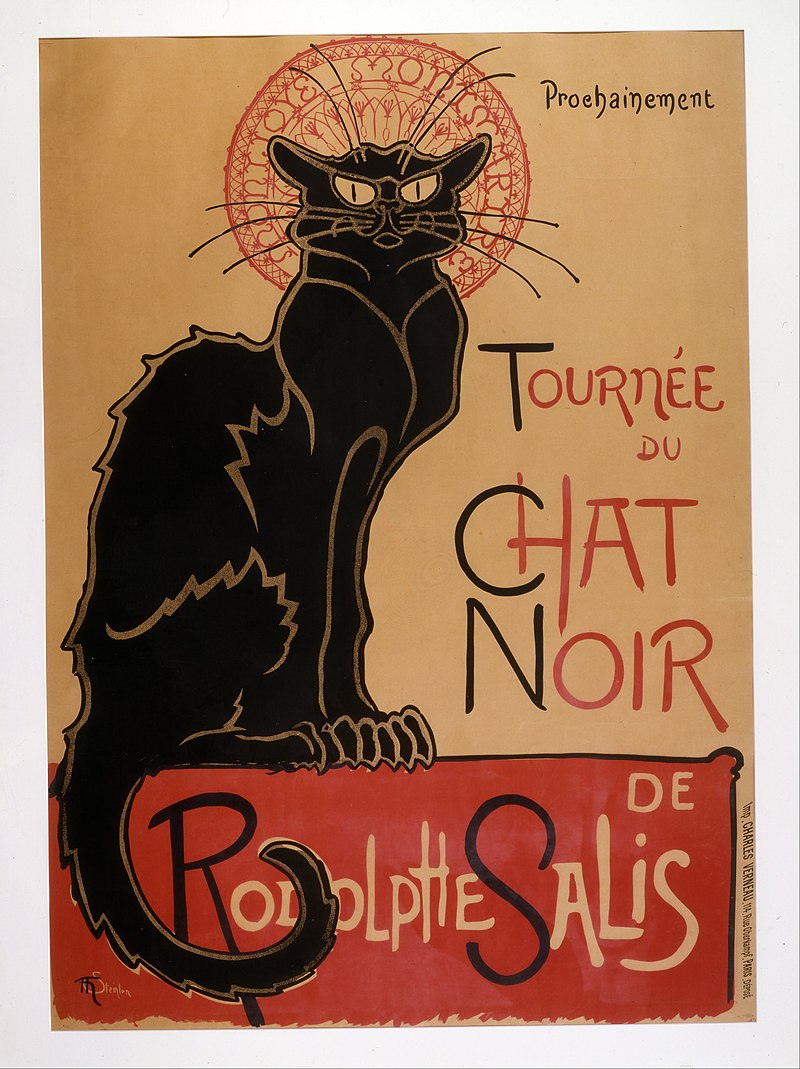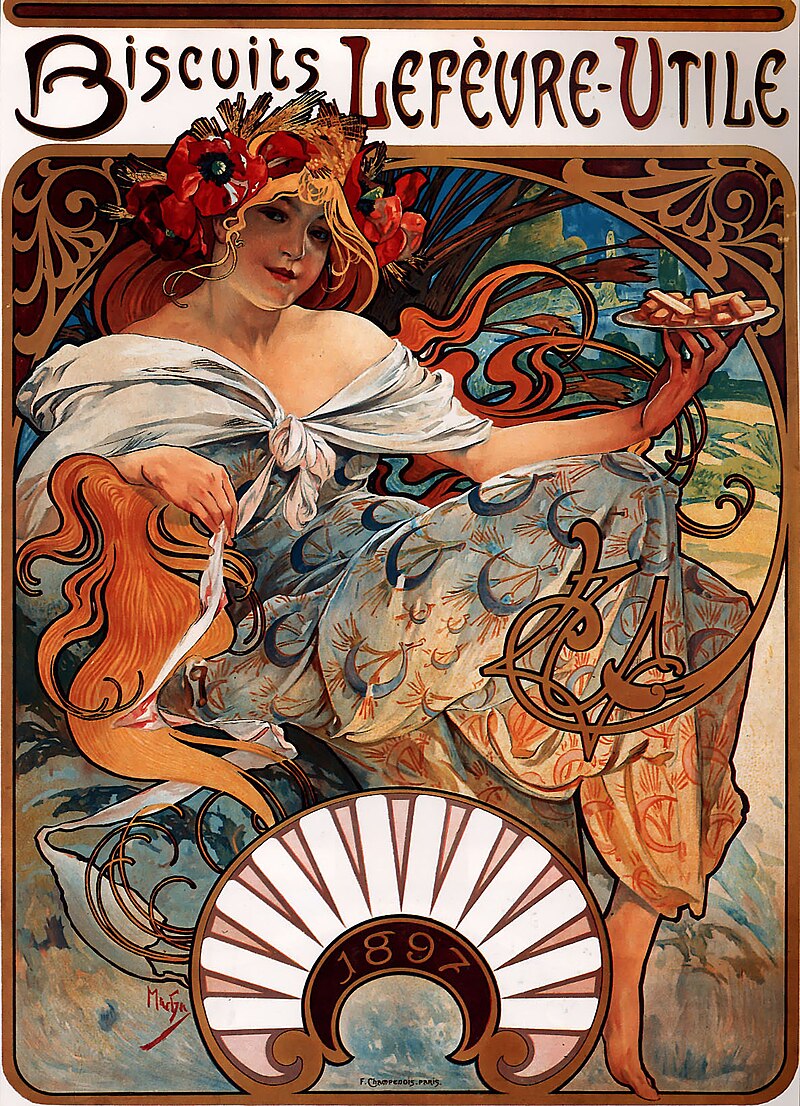Text from Wikipedia - the free encyclopaedia,
unless otherwise stated.
Poster design, by Louis John Rhead, advertising ‘Le Journal de la Beauté’, 1897.
Illustration: ART NOUVEAU STYLE
Art Nouveau is an international philosophy and style of art, architecture and applied art – especially the decorative arts – that was most popular during 1890–1910. The English language uses the French name Art Nouveau ("New Art"), but the style has many different names in other countries. A reaction to academic art of the 19th-Century, it was inspired by natural forms and structures, not only in flowers and plants, but also in curved lines. Architects tried to harmonise with the natural environment.
Art Nouveau is considered a "total" art style, embracing architecture, graphic art, interior design, and most of the decorative arts, including jewellery, furniture, textiles, household silver, and other utensils and lighting, as well as the fine arts. According to the philosophy of the style, art should be a way of life. For many well-off Europeans, it was possible to live in an Art Nouveau-inspired house with Art Nouveau furniture, silverware, fabrics, ceramics, including tableware, jewellery, cigarette cases, etc. Artists desired to combine the fine arts and applied arts, even for utilitarian objects.
Art Nouveau is considered a "total" art style, embracing architecture, graphic art, interior design, and most of the decorative arts, including jewellery, furniture, textiles, household silver, and other utensils and lighting, as well as the fine arts. According to the philosophy of the style, art should be a way of life. For many well-off Europeans, it was possible to live in an Art Nouveau-inspired house with Art Nouveau furniture, silverware, fabrics, ceramics, including tableware, jewellery, cigarette cases, etc. Artists desired to combine the fine arts and applied arts, even for utilitarian objects.
Although Art Nouveau was replaced by 20th-Century Modernist styles, it is now considered as an important transition between the eclectic historic revival styles of the 19th-Century and Modernism.

English: Tour of Rodolphe Salis' Black Cat.
Français: Tournée du Chat Noir de Rodolphe Salis.
Poster of 1896.
Artist: Théophile Steinlen (1859–1923).
Current location: Zimmerli Art Museum at Rutgers University,
New Jersey, United States of America.
Source/Photographer: BAEF9F-mDJvr0A at Google Cultural Institute.
(Wikimedia Commons)

English: Lefèvre-Utile Biscuits.
Français: Biscuits Lefèvre-Utile.
Artist: Alfons Mucha (1860–1939).
Date: 1897.
Current location: Private Collection.
Source/Photographer: Art Renewal Center Museum, image 4433.
(Wikimedia Commons)
Maison de l'Art Nouveau (House of New Art) was the name of the gallery, initiated in 1895, by the German art dealer, Siegfried Bing, in Paris, that featured exclusively modern art. The fame of his gallery was increased at the 1900 Exposition Universelle, where he presented co-ordinated — in design and colour — installations of modern furniture, tapestries and objets d'art. These decorative displays became so strongly associated with the style, that the name of his gallery subsequently provided a commonly-used term for the entire style. Thus the term "Art Nouveau" was created.
Part of the evolution of Art Nouveau were several International Fairs, which presented buildings and products designed in the new style. So, the 1888 Barcelona Universal Exposition marks the beginning of the Modernisme, with some buildings of Lluís Domènech i Montaner. The Exposition Universelle of 1900, in Paris, presented an overview of the 'modern style' in every medium. It achieved further recognition at the Esposizione Internazionale d'Arte Decorativa Moderna of 1902 in Turin, Italy, where designers exhibited from almost every European Country where Art Nouveau was practiced.

Tiffany Table Lamp.
Circa 1899-1902.
Tiffany Studios,
Tiffany Glass and Decorating Company.
Photo: November 2007.
Source: Own work.
Author: User:Piotrus.
(Wikimedia Commons)

Table Lamp.
Circa 1900, by Louis Comfort Tiffany.
Photo: 30 September 2010.
Source: Own work.
Author: sailko.
(Wikimedia Commons)
Many of these terms refer to the idea of "Newness". Before the term "Art Nouveau" became common in France, Le Style Moderne ("The Modern Style") was the more frequent designation. Arte joven ("Young Art"), in Spain, Modernisme, in Catalonia, Arte Nova, in Portugal ("New Art"), Arte Nuova, in Italy (also "New Art"), and Nieuwe Kunst, in The Netherlands.
In other cases, important examples, well-known artists, and associated locations influenced the names. Hector Guimard's Paris Métro entrances, for example, provided the term Style Métro, the popularity in Italy of Art Nouveau designs from London's Liberty & Co Department Store resulted in its being known as the Stile Liberty ("Liberty Style"), and, in The United States, it became known as the "Tiffany Style", due to its association with Louis Comfort Tiffany. In The United Kingdom, it is associated with the activities of Charles Rennie Mackintosh, in Glasgow, Scotland, and is often known as "The Glasgow" Style.
In other cases, important examples, well-known artists, and associated locations influenced the names. Hector Guimard's Paris Métro entrances, for example, provided the term Style Métro, the popularity in Italy of Art Nouveau designs from London's Liberty & Co Department Store resulted in its being known as the Stile Liberty ("Liberty Style"), and, in The United States, it became known as the "Tiffany Style", due to its association with Louis Comfort Tiffany. In The United Kingdom, it is associated with the activities of Charles Rennie Mackintosh, in Glasgow, Scotland, and is often known as "The Glasgow" Style.
Floral patterns by Stanisław Wyspiański (1869-1907).
Illustration: ART NOUVEAU STYLE

Book-Cover of Arthur Mackmurdo "Wren's City Churches", 1883.
Often cited among Incunabula of Art Nouveau.
(Wikipedia)
The origins of Art Nouveau are found in the resistance of the artist William Morris to the cluttered compositions and the revival tendencies of the 19th-Century, and his theories that helped initiate The Arts And Crafts Movement. However, Arthur Mackmurdo's Book-Cover for Wren's City Churches (1883), with its rhythmic floral patterns, is often considered the first realisation of Art Nouveau.
About the same time, the flat perspective and strong colours of Japanese Wood Block Prints, especially those of Katsushika Hokusai, had a strong effect on the formulation of Art Nouveau. The Japonisme, that was popular in Europe during the 1880s and 1890s, was particularly influential on many artists with its organic forms and references to The Natural World.
Art Nouveau entrance
to the French Metro,
Paris, France.
Illustration: DIGITAL EDITIONS
Besides being adopted by artists like Emile Gallé and James Abbott McNeill Whistler, Japanese-inspired art and design was championed by the businessmen Siegfried Bing and Arthur Lasenby Liberty at their Departmental Stores, in Paris and London, respectively.
Glass Canopy, Metro Entrance at Abbesses, in Montmartre, Paris, France.
While you are exploring Art Nouveau Paris, don’t forget the Metro Station entrances designed by Hector Guimard. He designed two versions, with and without glass roofs. Paris erected 141 of his designs; today, 86 remain. There are only two of the glass-roofed varieties, one at Porte Dauphine and one at Abbesses. A reconstruction of one is also at the entrance to Châtelet.
The simpler style, and the one you will notice more in Paris, is the "Metropolitan" sign
embraced by two Lamp-Posts resembling plants, although I always think the orange lamps
look like alien eyes (see photo, below).
You can find this in many locations around the City (Parc Monceau, St. Michel, Cité,
Palais Royal-Musée du Louvre, Nation, Victor Hugo)
Illustration: TRAVEL BEYOND PARIS
Metro Entrance at Saint Michel,
in the Quartier Latin, Paris.
Illustration:

Poster for "Motocycles Comiot, Paris, 87 Boulevart, Gouvion St. Cyr",
from "Maîtres de l'Affiche" (Masters of the Poster).
Artist: Théophile Steinlen (1859-1923).
Date: 1899.
Source: Maîtres de l'Affiche (Masters of the Poster) refers to 256 colour lithographic plates
used to create an art publication during The Belle Époque, in Paris, France. The collection, reproduced from the original works of ninety-seven artists in a smaller
11 x 15 inch format, was put together by Jules Chéret, the father of poster art.
The varied selection of prints were sold in packages of four and delivered monthly to subscribers. On sixteen occasions during the selling period, between December 1895 through November 1900, the monthly package included a bonus of a specially created lithograph.
A complete set, in five volumes, was sold in 2014 for US$43,450.
(Wikimedia Commons)
Wing-Sleeved Wool Coat,
with Fur Trim.
Circa 1910-1920.
via Whitaker Auctions.
Illustration: ART NOUVEAU STYLE

No comments:
Post a Comment